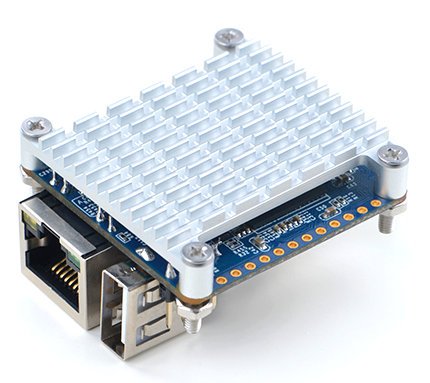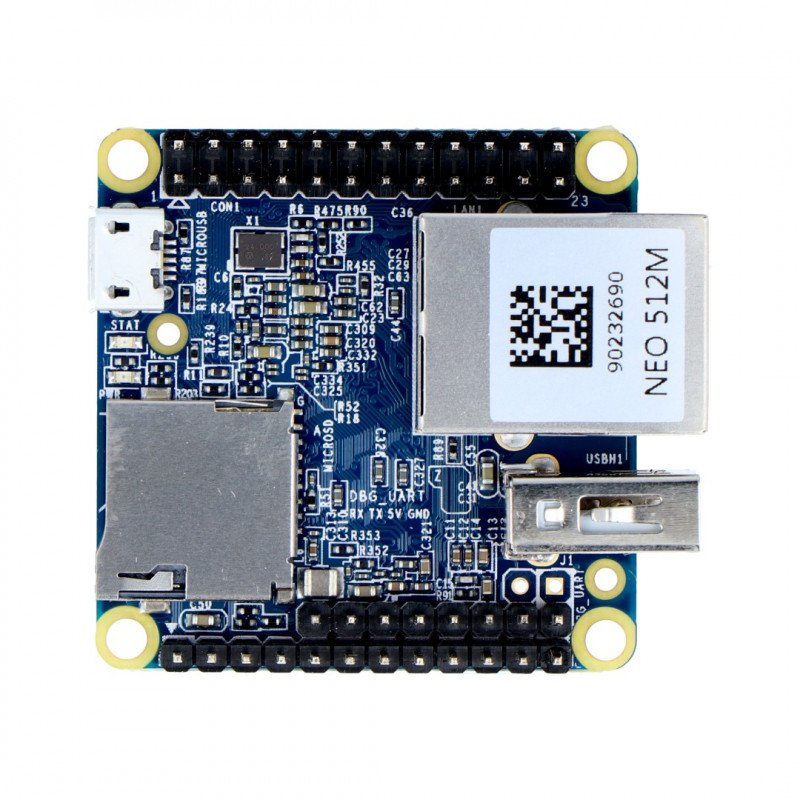Product description: NanoPi NEO v1.4 - Allwinner H3 Quad-Core 1.2GHz + 512MB RAM - with connectors.
MiniatureNanoPicomputer inNeo v1.4version with1.2 GHzAllwinner H3 quad-coreARM Cortex-A7processor. The board has512 MB ofDDR3 RAM, built-in portEthernetand aUSB + 2x USB Host slot on2.54 mm,36 GPIOpins, microSD card slot. Works withu-boot and UbuntuCoresystems.Version v1.4 has 4-pin audio interface, 2-pin CVBS interface, supports IC power control and has holes for heatsink mounting.
The device has a USB port, connector and Ethernet port and many others.
What is needed to run a NanoPi minicomputer?
- MicroSD memory card- the media on which the operating system will be installed.
- Powersupply unit with microUSB- 5 Vplugwith 2 A current capacity
Operating system for NanoPi Neo
NanoPi works with systems prepared by the manufacturer: u-boot and UbuntuCore. The disk of the device can be a microSD card, which can be purchased in our shop.
|
Operating systems can be downloaded fromthe manufacturer's website.The manufacturer also provides asystem installation guide. |
Communication of NanoPi Neo minicomputer
The minicomputer has basic communication interfaces that can be found in PC-class office computers. In addition to the previously mentioned audio and video interfaces, the user has the possibility to use them:
- 1x USB A + 2x USB Host connector on 2.54 mm pins,under which you can connect e.g. a mouse, a keyboard, a WiFi card or a flash drive. If it turns out that there are too few sockets, you can increase their number usingan external USB HUB. The interfaces on the pins can be connected with cables.
- Ethernet socket, i.e. possibility of direct connection to the LAN.
- GPIO x 36 pin- general purpose outputs/inputs that can be used to operate LEDs, buttons,motorcontrollers. Among them there are pins supporting interfaces: I2C, SPI and UART. Pins should be soldered on their own,goldpin raster strips 2.54 mmcan be purchased in our shop.
- microSD slot- a slot for a microSD memory card, on which the operating system can be installed.
NanoPi Neo power supply
The system uses the microUSB connector as the power source. The manufacturer recommends that the voltage given on the connector should be 5.0 V, while the current capacity of the power supply used should be at least 2.0 A. In our offer you will findpower supplies meeting these parameters.
In our offer you will also finda dedicated heatsink.
Specification |
|
| Model | NanoPi Neo |
| Specification |
|
| Processor | Allwinner H3 |
| Core | Quad-Core ARM Cortex A7 |
| Systems | u-boot UbuntuCore |
| Clocking | 1.2 GHz |
| Memory RAM | 512 MB |
| Memory | microSD card |
| GPIO socket | 36-pin connector |
| Power supply | 5 V / 2 A - microUSB |
| Dimensions of the tiles | 40 x 40 mm |
| Interfaces | |
| USB Host | 1 x USB socket A 2 x USB Host on 2.54 mm pins |
| Network interface | Ethernet 10/100 Mbps |
| Video | - |
| Audio | audio output and microphone on GPIO connector |
| Communication | UART, SPI, I2C, GPIO |
| Debugger | Serial port 4pin / 2.54mm |
| Additional | Built-in LED CVBS 2-pin interface Supports IC power control Heatsink mounting holes |























































































































































































































































































































































